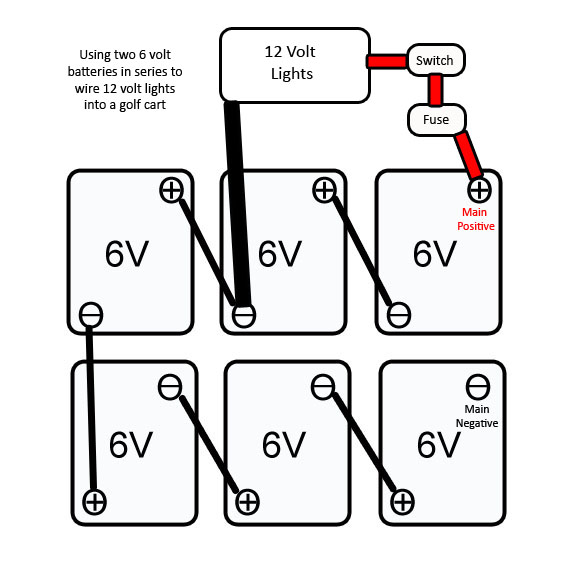Go to the golf cart web sights.....it's simple and they offer a little device made just for external loads, balanced discharge, and balanced charging cycles.
36 Volt Golf Cart Electrical Accessories Installation
Installing electrical accessories into a 36 volt electric powered golf car provides a bit more of a challenge since the battery bank does not provide 12 volts already as in the gas installation above. Luckily, 36 volt systems generally use six deep cycle 6 volt batteries and six is a divisor of twelve. There are two options when attempting to provide a suitable 12VDC power source from a 36 volt battery bank – one is adequate, the other is correct and preferred.
The first option which is adequate, but not preferred, is to use two deep cycle 6 volt batteries in series to provide the 12 VDC. This method will work fairly well if you keep the accessories to a minimum such as just a set of headlights or a horn. However, if you are installing many accessories, this is not the route to pursue, even if you use a different set of two batteries from the battery bank for each accessory. It will eventually present problems and if a particular accessory is left ‘ON’ while the car is in storage or unattended, you may cause permanent damage to those batteries or greatly reduce their life. As in the gas example above, the negative or ground wire is wired directly to the negative battery terminal of the second battery in the series (series of two 6 volt deep cycle batteries). The positive wire runs from the accessory to an ‘ON/OFF’ or actuating switch, through a fuse block or inline fuse and then to the positive battery terminal on the first battery in the series. The negative terminal on the first battery in the series will lead to the positive terminal on the second battery without any additional wiring due to the power wiring circuit of the vehicle.

The second option is to use a voltage reducer to “reduce” the power from the entire 36 volt battery bank to a usable 12VDC. Voltage reducers draw power evenly from the entire battery bank rather than from just a few as in the first method. This method ensures that all batteries are used evenly to prevent the premature death of any single battery. It is also much simpler to wire this option. The voltage reducer is wired to the main negative terminal of the entire battery bank and the main positive terminal of the battery bank. Each accessory is wired to its respective actuation switch through a fuse block and directly into the voltage reducer for the 12VDC power source.
We carry 10 Amp and 25 Amp versions of these voltage reducers. The 10 amp version will power head lights, tail lights, and a horn, but doesn’t leave much amperage for future accessory expansion. The 25 amp version will handle a whole lot more accessories. You will have to research each accessory you are adding to the car in order to determine the amperage draw of each and ensure you buy the correct reducer for the application.



